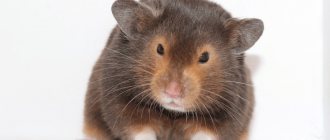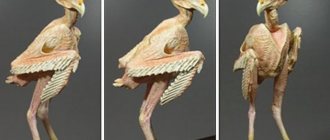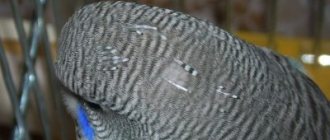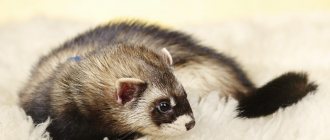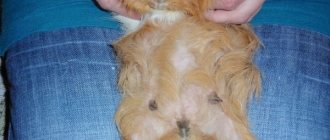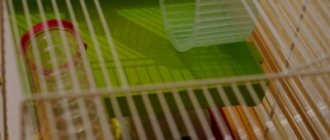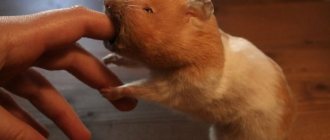A healthy hamster's coat is thick, shiny and silky. But there are periods when the pet renews its fur and in the process loses part of it - this is a normal phenomenon. However, baldness often occurs due to vitamin deficiency, allergic reactions, parasites, and infectious diseases.
Let's find out what other causes of hamster baldness are and how to prevent the development of such diseases.
Natural hair loss in hamsters
Your perfectly healthy hamster is starting to go bald. What's wrong with him? He is active, eats well, but the fur of his fluffy coat has begun to fall off like leaves in autumn.
Seasonal molt
In the wild, these animals undergo seasonal molting. The old fur falls out and new fur appears in its place. When keeping hamsters at home, this process can take a long time, and the owner will not immediately notice that the pet has begun to shed. It happens that the process of changing fur is extended over time and it happens in such a way that the owner of the animal does not see the difference at all. Gradually one cover replaces another.
It's all individual. The seasonal change of fur differs from the pathological color of the coat. Seasonal molting, as a rule, occurs intensively on the abdomen of the animal and the inside of the limbs of hamsters. It is almost invisible on the back ridge.
Causes
It is necessary to distinguish between individual keeping of hamsters in a personal cage and group keeping. The reasons for their molting are not the same. So, if the hamster is kept at home in a cage and there are no other animals, hair loss can occur for the following reasons:
- Unbalanced diet.
- Allergy. Reaction to a new ornamental plant, filler.
- Sudden change of food.
- Poisoning by food or vitamin supplement that is unusual for a hamster. The body tries to remove toxic substances in any way, including wool.
- Loss of immunity as a result of illness. Hamsters suffer from overheating more severely than from hypothermia. They tolerate frost, but are defenseless against drafts.
- Unsanitary conditions. The fur becomes contaminated with urine and falls out.
- Stress. Moving, fright.
- Old age. Before death, the fur loses pigmentation and slowly comes out.
- If there is a cat or dog in the house, it is theoretically possible, although unlikely, for fleas to jump onto the hamster.
For group housing in non-residential premises, the following reasons are added:
- With high humidity, fungal diseases develop.
- When a hamster comes into contact with mice, it gets scabies or lichen.
- During lactation, fur falls out due to unbalanced nutrition.
Age
A natural phenomenon is hair loss in old hamsters. Your pet has been living with you for more than two years; it has no skin diseases, but its fur is thinning. The reason lies in the fact that hamsters, on average, live three years.
One year for a hamster is like our twenty-five years. Some people start going bald after thirty. A two-year-old hamster is like a fifty-year-old man. Your beloved furry pet is just getting old. And, sad as it may be, the fur thins out only due to the hamster’s advanced age.
This is the case when your pet's fur loss is not a concern. Your task is to care for your hamster so that he comfortably lives out his hamster life.
Diagnosis of rodent diseases
If you yourself were able to determine why your hamster’s hair is falling out and found the source of the unpleasant causes, immediately remove the irritant and observe the animal’s further reaction. The situation when a pet has suffered baldness due to intolerance to the bedding or material renewal in the cage can be quickly corrected without serious consequences.
If your hamster has eaten previously unfamiliar foods or low-quality food, return him to his previous diet and make sure that the food is fresh and of decent quality. By eliminating allergens, the hamster will soon recover. When the reasons lie deep and only a specialist can determine them, do not waste time and seek veterinary help.
Possible diagnoses and treatments:
- Poor or unhealthy diet. If the cause of the disease lies in the rodent’s diet, the doctor will recommend changing the diet, and in some cases will prescribe a separate dietary menu for the rodent. This could be a diet with lots of greens, with a variety of nutritional supplements that the animals can eat. Correct diagnosis and timely treatment will allow the animal to become healthy within a month. The first signs of a successful cure appear already in the first week: the development of the disease stops, and the bald parts of the skin begin to grow with new fuzz.
- Fungi or viruses. They are characterized by symptoms when the animal's skin peels off, accompanied by hair loss. When an infection of this nature is detected, rodents are prescribed special ointments, which can be easily purchased both in the clinic itself and in veterinary stores. The ointment is regularly applied to the affected areas of the skin until the signs of baldness disappear. In order to consolidate the result and prevent it, you can repeat the application of the ointment several times even after the rodent has recovered.
- Allergic reactions. It is quite difficult to detect the cause of the allergy, so the doctor will ask you to remember the next few days before the onset of the disease. This could include possible changes in the cage (new litter or toys), as well as the rodent’s diet in detail. By the way, at the first symptoms of baldness, it is important to ask yourself such questions. If the animal is offered a different filler, replace it with the same one and thoroughly wash the cage. Preferably with a disinfectant to eliminate residual reactions. Do not use chlorine because it is harmful to the animal. Pay detailed attention to your hamster's nutrition. To eliminate food poisoning, you can temporarily switch your animal to dry food.
- Stressful situations. If a hamster loses its fur, but there are no other reasons why the animal began to go bald, stress may be to blame. The rodent will need absolute rest. Place the cage in a quiet place, try to rid the animal of sharp and loud sounds. Give him a good rest, including from your own attention. The animal needs time to get back to normal.
- Age-related changes. Unfortunately, rodents age very early and already at the age of 2 years show the first signs of impending death. Some individuals begin to lose fur at a slightly earlier age. In this case, nothing can help the animal. Try to surround him with care and pamper him with delicious treats, making his days carefree and cozy.
Hair loss can be avoided through a balanced diet. Feed your rodent high-quality foods, add vitamins to the diet, but do not forget that their excess can have unpleasant consequences. Create favorable and comfortable living conditions for the animal: regularly wash the cage, offer toys for an active lifestyle and make sure that the animal is not exposed to stress. Surrounded by care, the hamster will feel great, delighting its owner with vigor and good health.
>
The hamster has spots
Pathological hair loss in hamsters
Lichen
Has your hamster started to itch, its skin is peeling, and its fur has become sparse? This is a reason for some concern for the health of their pet and a signal for owners that it is time to contact a veterinarian.
Many people think that the problem is an allergic reaction and waste time in starting treatment. Microscopic fungus can cause skin lesions. As a rule, this is microsporia or trichophytosis.
The shape of a receding hairline resembles a circle; broken hairs are noticeable in these areas. They are localized in the area of the muzzle, ears and sides. Initially, the area is quite smooth, over time it becomes inflamed and then, if you do not start treatment, suppuration and scabs appear.
The doctor may say it's shingles. It is dangerous not only for rodents, but also for everyone living in your apartment, other pets and, of course, people.
The cause of the appearance of lichen can be infection by the person himself of his hamster. Coming from the street, he can bring infectious agents on his outer clothing or unwashed hands.
The hamster's behavior changes; he may become aggressive and lose his appetite. Do not self-medicate . Only a veterinarian can correctly diagnose and prescribe treatment for your pet.
Prevention
The disease is easier to prevent than to treat. With regard to skin diseases in rodents, the following measures must first be observed:
- do not approach the hamster in street clothes and shoes;
- handle your pet with washed hands;
- follow quarantine rules after acquiring a new animal;
- maintain the animal’s home in good sanitary condition;
- protect your pet from stressful situations.
If trouble happens and the pet dies from skin problems, then before purchasing a new hamster you need to do a general cleaning of the room and thoroughly disinfect all equipment and the cage.
The health of pets depends on the owner. Inattention and negligence can destroy even such an unpretentious creature as a hamster.
Demodex
Sometimes small dense formations without any vegetation appear on the hamster's face. Over time, these formations converge into a large bald patch, which runs like scabs along the neck, withers, and intense hair loss begins on the hamster’s back. Your baby may have become infected with demodex. With this disease, animals rarely experience itching.
Demodex is a microscopic mite measuring no more than a third of a millimeter. It parasitizes the sebaceous glands of the skin. Likes to settle in hair follicles, in the glands of the cartilage of the eyelids. Lives on both humans and animals. Demodex causes great harm to the organism on which it parasitizes.
But the diagnosis that your hamster is infested with microscopic mites must be made by a veterinarian who takes scrapings from the rodent's skin.
Why does shedding occur?
All animals sooner or later begin to change their fur. Hamsters are no exception. This can occur for several reasons.
- Due to age. The bottom line is that at the age of 5 months, hamsters can change their fluffy fur to denser hair (molting is observed).
- Due to seasonal processes. Hamsters shed only in spring and autumn. This is due to the fact that weather conditions are changing.
Usually the molting process cannot be seen with the naked eye. If your rodent is not sick and is quite active, then there is no need to worry. This is a normal physical process that cannot be influenced. For example, small Djungarian hamsters have only three coat colors. As soon as they “survive” the moult, the number of shades doubles.
Skin parasites
Your hamster is itching and his hair has started to fall out. The scratched area not only becomes bald, but also begins to become inflamed. The animals begin to scratch desperately, as severe itching appears. He may have developed skin parasites.
These include:
- fleas;
- lice;
- lice eaters;
- scabies mites.
And here a veterinarian will help make an accurate diagnosis. He prescribes the treatment that is relevant in this case, taking into account the dosage of medications, commensurate with the size of different breeds of hamsters.
Cystitis
Inflammation of the bladder or cystitis often occurs from hypothermia. Rodents do not have good thermoregulation, so even an ordinary draft can provoke it.
The most important rule is to protect your pet from hypothermia:
- hide it from the fan and open windows;
- remember its sensitivity to temperature changes;
- protect from drafts.
Simple rules, but how many difficulties can be avoided by simply closing the window in time! With cystitis, a hamster experiences a burning sensation when urinating and constant pain in the lower abdomen. He won’t be able to talk about it, but it’s possible to find out about the disease. As with colibacillosis, cystitis makes the hamster's fur wet. Losing fluid in such quantities can lead to dehydration.
It is because of the similarity of symptoms that you need to seek a final diagnosis from a specialist. If you suspect inflammation of the bladder, you should immediately go to a veterinary hospital, where they will tell you exactly what happened to your pet. Typically, for cystitis, your veterinarian will prescribe antibiotic treatment. To prevent this, it is better to take care of your pet’s health in advance.
Avitaminosis
Vitamin deficiency manifests itself in peeling skin and hair loss on the animal’s ears. There are no inflammatory processes in these places. The cause of vitamin deficiency is improper feeding of hamsters. Mostly dry food and cereals give this result.
In this case, it is important to feed the hamster varied and balanced.
Give him fruits, vegetables, greens. Occasionally offer him a boiled egg or even pieces of meat. At the pet store, purchase vitamin supplements to feed sick rodents.
How to prevent baldness
To avoid possible hair loss, provide your pet with comfortable living conditions. Protect him from stress, offer toys for an active lifestyle. Keep the cage clean - wash it regularly and change the bedding. A correct and balanced diet is very important: only high-quality products should be on the menu, periodically give the animal vitamins, but do not overdo it. If you surround your hamster with love and care, he will feel great and delight you with his health and good mood.
Stressful situation
When stressed, hamsters work hard with their scent glands and, due to this intensity, begin to lose their thick fur. Hamsters are loners, leading an active nocturnal lifestyle. Intrusive imposition of your attention, changing rhythms with interruption of sleep during the day, loud screams of people, sounds of audio systems can bring severe discomfort to your pets.
Perhaps you have moved, or just bought your pet. Give him time to adapt so that he understands that there is nothing in danger for him here. Don't pick him up for a while. Let him get used to it.
What to do
If changing the bedding, good care and a nutritious diet have not stopped the hamster’s hair loss, then a visit to the veterinary clinic is essential. Unfortunately, not all doctors undertake to treat rodents.
Try to find a blade that has a specialist - a ratologist.
If there is no such hospital, the Internet will come to the rescue. Post good photographs of your pet on specialized veterinary websites, describe the problem in detail and get qualified advice.
Hormonal changes in females
Females nursing their young have bald patches on the abdomen, in the area of the mammary glands. The fur grows back after the mother stops feeding her milk to the hamsters. While bearing offspring, a pregnant female may lose fur intensively.
Separately living females may have reproductive diseases that lead to baldness. They may have polycystic ovary syndrome, inflammation of the uterus. In this case, hormonal alopecia is observed in the form of symmetrical bald spots along the sides. At the same time, hamsters do not itch.
Lichen
This is a skin disease caused by a viral infection or microscopic fungi. Depending on the pathogen, there are two types of lichen: ringworm and pink lichen.
Rodents with weakened immune systems, mechanical trauma to the skin, and elderly animals are at risk of infection.
The following symptoms are typical for lichen:
- baldness;
- the appearance of inflamed areas;
- itching;
- loss of appetite.
If the disease is confirmed, the sick hamster is isolated from other pets, the cage, bowls, wheel and all objects that came into contact with the infected animal are disinfected. The most effective means for this will be a formaldehyde solution or a sulfur-carbolic mixture.
For treatment, antifungal drugs are used, which are prescribed by a specialist, who will also tell you the dosage and duration of the course. Hair is removed from damaged areas of the body as they are contaminated with fungal spores.
Dried crusts are softened and cut off, the area is treated with salicylic ointment, and the edges are treated with iodine. It is also recommended to support your pet’s body with immunostimulating drugs and probiotics during the treatment period.
Ringworm
A characteristic feature is rounded bald patches on the front of the body and muzzle.
Further, these bald spots become inflamed and form purulent ulcers, through which the fungus enters the body, poisoning it with toxins and causing itching throughout the body.
The disease is transmitted from humans to animals and vice versa.
Pityriasis rosea
The main difference from other skin diseases is the appearance of hairless pink areas of skin, more saturated at the edges than in the center.
It is not dangerous for humans - unlike trichophytosis (the scientific name for ringworm), it is not transmitted through household contact.
Fleas
They are extremely rare in hamsters; infection mainly occurs from other domestic animals - cats or dogs.
If your pet develops itching, skin rashes, baldness over large areas of the body, dandruff, and crusts, a flea infestation can be suspected. In this case, it is necessary to take urgent measures to eliminate them.
Anti-flea medications used for dogs and cats are not suitable for hamsters and can be harmful to their health. To get rid of fleas, special antiparasitic agents for rodents are used.
Dermatophytosis
A skin disease caused by dermatophyte fungi that feed on hair and dead cells. The infection is also known as ringworm because the red lesions appear in rings on the skin.
There is severe peeling along the edges of the spots, while the surface in the center is absolutely healthy.
Dermatophytosis poses a threat to households - it can be transmitted from animals to humans.
Treatment is selected by a specialist, usually using external agents such as Yam or Fungin ointment, Zoomekol aerosol, chlorhexidine, and sometimes oral medications. The duration of therapy is 1-2 months.
Don’t forget about disinfecting the premises – fungal spores are viable for up to 4 years.
